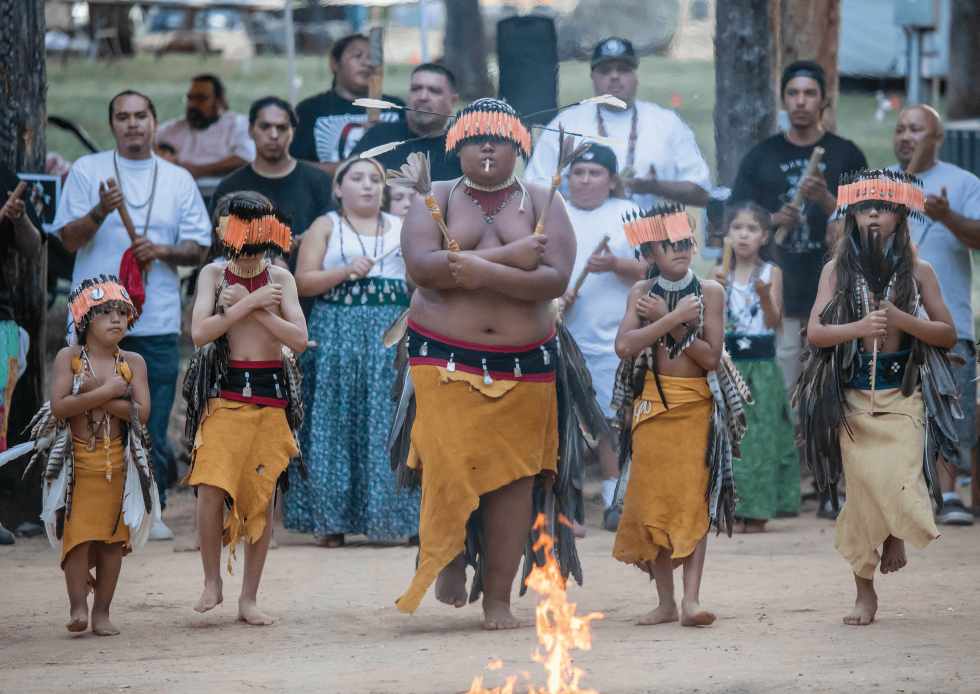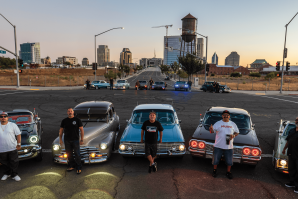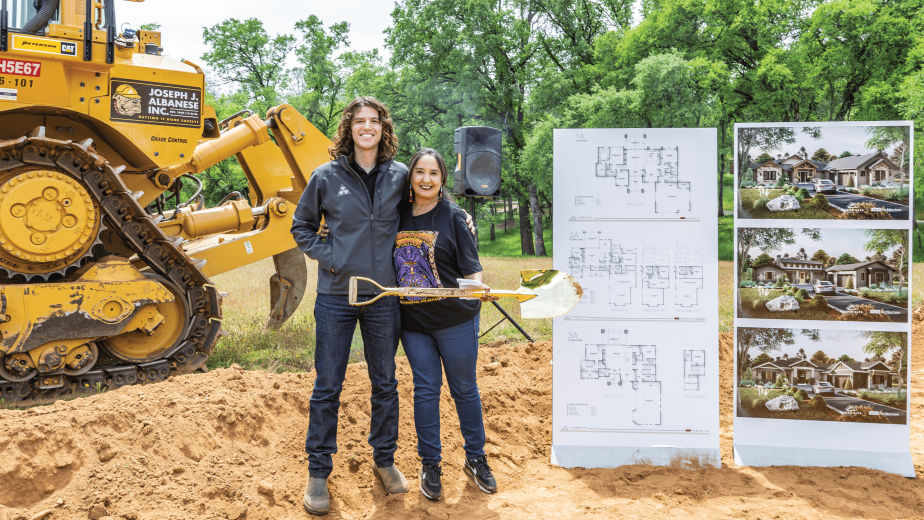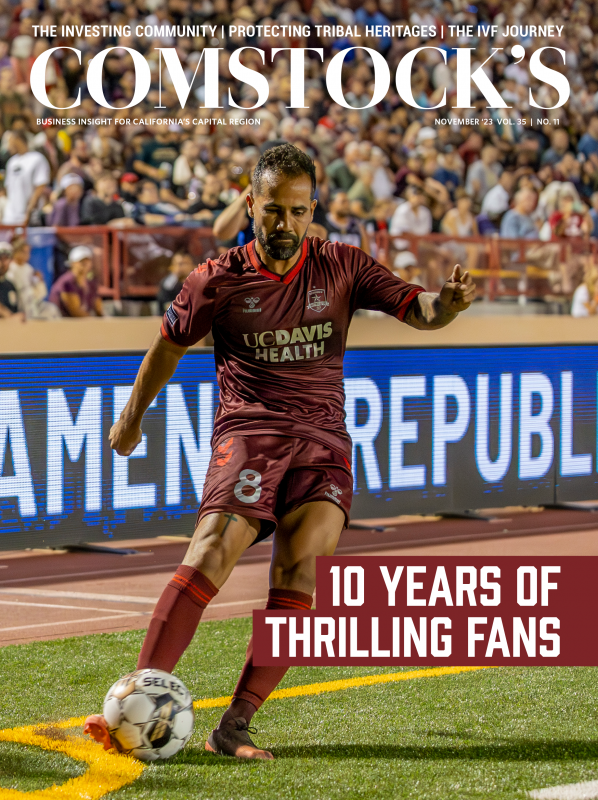Malissa Tayaba, vice chair of the Shingle Springs Band of Miwok Indians’ Tribal Council, steps through an attentive crowd that’s transfixed by a group of dancers in feather-trimmed regalia, following the stringent beat of clapper sticks. Today’s event is the annual Big Time celebration, and it is being held on the tribal rancheria that is also home to the Red Hawk Casino and Resort near Placerville. Tayaba grew up on this slope of government-allotted tribal land.
She maneuvers through the savory vapors of “Indian tacos” (frybread with various toppings) before heading into a maze of blankets, beads, shell jewelry, and fox and coyote pelts for sale. The scene is vibrant, but Tayaba knows that this corner of the oak woodlands looked very different when she was young. Back then, as she describes it, the reservation was just a smattering of trailers with no running water.
“When you talk about business, ours has allowed us to bring our culture back.”Malissa Tayaba, vice chair, Shingle Springs Band of Miwok Indians’ Tribal Council
Now, the property has a spacious casino with bars and restaurants, a government building and tribal arts museum, not to mention a health clinic that’s become vital to the broader population in El Dorado County.
It was a long struggle to make this dream a reality, but the result includes moments like today — those instances when the tribe can host events that celebrate and explore its heritage. And like numerous Native groups in Northern California, the Shingle Springs Miwoks are using the revenue from their businesses to fund a battery of ongoing cultural preservation efforts.
“When you talk about business, ours has allowed us to bring our culture back,” Tayaba notes. “Building our dance arbor, having our ceremonies — obtaining eagle feathers, abalone, clam shells, pine nuts, items that aren’t easily foraged today — it all costs money. Now we hold workshops, classes, dance practices. We’re trying to rebirth weavers, because our grandmothers were weavers.”
Regina Cuellar, the tribe’s chairwoman, agrees and stresses that when it comes to cultural preservation, her people are just getting started.
“We’re just barely beginning to hit our stride and find that good flow,” Cuellar says. “I think we’re really on the cusp of doing what we need to do.”
In October, California State Parks and the Miwok tribe agreed to a new pact that preserves and protects parks on their ancestral land. The 5-year agreement was signed in West Sacramento, where the state’s new California Indian Museum will be located.
Protecting the seen and unseen
Whenever Ivan Senock watches a shovel crack soil under the twin buttes by Lake Camanche, he can envision how open the brushy territory was when it was the home of a pioneering Me-Wuk named Casus Oliver. The “Headman” of tribal people in the area, Oliver wandered its granite ridges and windbreak trees from the 1880s until his death in 1916, a guardian of Me-Wuk and Upusani identity.
Young dancers perform at the Shingle Springs Band of Miwok
Indians’ Big Time celebration on their tribal rancheria land near
Placerville. (PHOTO COURTESY OF Shingle Springs Band of Miwok
Indians)

Now, in many respects, Senock has a similar role as the historic preservation officer for the Buena Vista Rancheria of Me-Wuk Indians. For starters, he’s an official monitor for any construction projects that might accidently unearth native burial grounds or lost spiritual sites. This area around Lake Camanche held Native villages for thousands of years before Oliver put a homestead on it. The fact that Amador and Calaveras counties have a tribally run system in place to handle such delicate issues is largely thanks to Oliver’s work keeping his people together for a century.
According to records, Oliver was a child when he and his mother were among the tribespeople who were taken to Mission San Jose in the early 19th century to be essentially enslaved. Before that, Oliver’s mother had grown up in a part of the rolling oak woodlands that shroud Lake Camanche in modern Amador, Calaveras and San Joaquin counties. Her son would eventually make it back to this region years later, settling in a picturesque valley near the lake called Buena Vista.
Oliver’s family lived on this land in south Amador for multiple generations, and the federal government established it in 1985 as a rancheria for their tribal lineage. In recent times, Oliver’s great-great granddaughter Rhonda L. Morningstar Pope led the effort to build Harrah’s Northern California casino on the reservation and then use its revenues for Me-Wuk cultural preservation. Part of that mission has been funding a team of specialized construction monitors, overseen by Senock.
“If a monitor finds human remains or cultural objects during construction, it’s up to the contractor to stop the project a hundred feet in every direction and contact the Native American Heritage Commission in downtown Sacramento,” Senock explains. “If it’s remains, they also have to contact the county coroner to come out and determine if they’re modern or historic remains. If they’re historic, the site has to be reviewed, and there has to be consultation with all the associated tribes in the area.”
At that point, the contractor and the Native American Heritage Commission work together on a path forward for the stalled project. The Shingle Springs Band of Miwoks also has monitors engaged in the same process.
Can the public view such artifacts or authentic replicas in a setting that’s curated by an actual tribe rather than outside academics? Thanks to the Shingle Springs band, the answer is yes. It created a dazzling tribal art display within its own government building, one that includes traditional skirts, necklaces, baskets, blades and headpieces. Three years ago, the band started working with the Sacramento History Museum to be the official curators of a recently opened exhibit about Native peoples of the local rivers.
“The things in that display were all done with our native plants — plants we’ve learned how to gather, and used for regalia that we’ve learned how to make again,” Cuellar points out. “I think the partnership with the museum led to a beautiful display.”
Dustin Murray, a tribal administrator for the Shingle Springs Band who grew up on the reservation and graduated from UC Berkeley, thinks the approach of having his people act as the curators represents a sea change in how California history is taught.
“The leadership at the Sacramento History museum was really taking the plunge to change the common perception of Sacramento’s past, leaning away from the more colonized viewpoint of it,” Murray says. “This really embraces the true history of the region. And part of that — the only place you can start really — is talking about the first peoples there and their connections to the waterways.”
Lasting words and memories
The day before this year’s Big Time celebration, the Shingle Springs Miwoks hosted a seminar about their language, part of the endangered Miwok language group once spoken from the Bay Area to the Sierra Nevada. Some of the tribe’s business revenue goes toward maintaining Miwok language skills, which offer speakers an indelible way to connect with their identity, their ancestors and each other.
“I grew up on this reservation, and when I was here, it was a much different time — we lost our language,” Tayaba remembers, noting that her brother, John Tayaba, is a continuously learning speaker of Miwok. John accomplished that feat by speaking with elders wherever he could find them, using grant funding to research elements of linguistics, incorporating the language into his household with his kids and communicating with numerous other tribes.
For Cuellar, a cousin of John Tayaba, such developments are critical.
“We’re going to start having our first language speakers,” Cuellar says. “Our little ones are starting to learn — learn the words. Some of the kids can speak it better than I can. We’ll have our first generation of speakers again, and we can’t wait for that day.”
Senock says that the Buena Vista Rancheria is also fighting to rescue Me-Wuk, a related member of the Miwok language family. That starts with the tribe including it in sessions at its cultural center, and extends to posting signage all around its properties — posters that identify everything from restroom doors to pictures of plants and animals in Me-Wuk. Since Senock’s own department does so much work with archeologists and ecologists, he says he’s sometimes able to help different bands find specific Me-Wuk words they’re searching for around plants and landscapes. He adds that, generally, the pandemic years were terrible reminders about how fragile the language’s future might be.
“There are very few speakers, and something COVID really showed us is just how vulnerable our elders are,” Senock reflects. “We had very large numbers all across Indian country of elders who passed because of COVID. So now, just trying to learn what the tribes spoke, and the different communities now speak it, is key.”
Reclaiming spaces
The Shingle Springs Band of Miwoks is based in the El Dorado foothills, but they were traditionally fishing people along the Sacramento and American rivers. Now, with building resources, its members are getting back to their roots as river guardians. That includes the band funding various legal challenges to the California Department of Water Resources and State Water Resources Control Board over policies that it believes are detrimental to the wildlife and ecosystem in the Delta and its tributaries.
“That disconnection from the river is something that happened physically, but spiritually we’ve always been connected,” Tayaba says. “When we go back to our original village sites to collect for ceremony, the state of the water, the state of the plants, it’s not good. … We want to protect the water, but also the ones who cannot speak for themselves — the animals, the plants.”
The Shingle Springs band also recently managed to buy back a specific village site at the confluence of the Feather and Sacramento rivers in Sutter County, a place that was taken from their forebears more than a century-and-a-half ago. Today, it’s called Verona Marina, though in Miwok it’s known as Wóllok, or “the village of the flicker bird.” The band has since held spiritual ceremonies there, which Tayaba describes as magical.
“When we were able to get that space back, that was just a moment in time to remember, because we were able to touch the water again,” she observes. “Things like that are what tell us we’re going in the right direction — doing the right things. It’s so nice to be able to bring our kids back there, and teach them, on the river — teach them about fishing and all of the things that we need to learn.”
Stay up to date on business in the Capital Region: Subscribe to the Comstock’s newsletter today.
Recommended For You

With ‘Boulevard Dreams,’ the Sacramento History Museum Focuses on Lowriders — as Cars and as a Cultural Touchstone
A ‘paradigm shift’ for a treasured local institution
More than two dozen 1950s and ‘60s vintage cars were parked in a semi-circle in front of the Sacramento History Museum’s entrance, heralding attendees to enter a world they had likely encountered over the past several decades but may have feared or simply misunderstood.

Sacramento Republic FC Celebrates 10 Years in the State Capital
The soccer club has captured the heart of the region with its successes
While other professional soccer teams have come to town with hype and promise, only to flicker briefly before disappearing — teams like the Gold, Spirits, Geckos, Scorpions, Senators and the Knights — the United Soccer League’s Sac Republic connected with the Capital Region in a major way.

Startup Revolution
The Capital Region’s emerging startup community is attracting big investments
Since 2020, the global economy has been mired in uncertainty. On Oct. 5, 2023, investors and entrepreneurs convened at the Roebbelen Center @The Grounds in Roseville to address certain questions regarding business in the Capital Region.

California State Scientists Strike, Demand Equal Pay
CalMatters: Hundreds of scientists working for the state of California to protect water supplies, respond to oil spills, study wildlife and track foodborne outbreaks marched in Sacramento Nov. 15 in what’s being called the first-ever strike by state civil servants.




